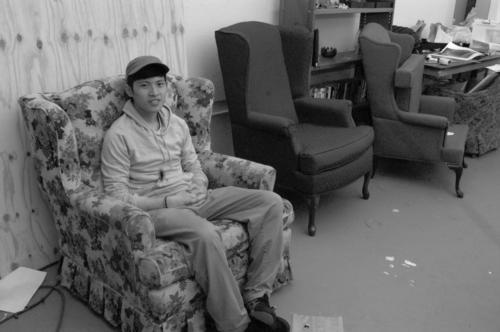
News
‘Deal with the Devil’: Harvard Medical School Faculty Grapple with Increased Industry Research Funding

News
As Dean Long’s Departure Looms, Harvard President Garber To Appoint Interim HGSE Dean

News
Harvard Students Rally in Solidarity with Pro-Palestine MIT Encampment Amid National Campus Turmoil

News
Attorneys Present Closing Arguments in Wrongful Death Trial Against CAMHS Employee

News
Harvard President Garber Declines To Rule Out Police Response To Campus Protests
Enzo Camacho '07

Given the astonishing presence J. Lorenzo “Enzo” Camacho ’07 has on the campus visual arts scene today, it might come as a surprise to many that Camacho had not formally pursued visual art before college. Rather, he explains, his interest in the medium devloped gradually.
“I sort of fell into the visual studies concentration. I came to college with a vague interest in filmmaking,” he explains. “Freshmen year, I took a photo and experimental video class and, in my sophomore fall, I comped The Advocate arts board and got on. That’s where I figured out I wanted to do Visual Studies seriously.”
His work spans a wide range of media and topics.
“The most recent stuff that I’ve been working on is my thesis,” says Camacho. “Basically, what I did is to take objects associated with domestic comfort and take them apart, recreating and re-inscribing them.”
To accomplish this, Camacho bought second-hand chairs from the Salvation Army and embroidered excerpts from stories about the supernatural onto their undersides. He subsequently donated the chairs back to the Salvation Army so they could be put back in circulation.
When questioned about the project’s message, he was reluctant to answer directly. “I don’t like to have work that can be explained in one way,” Camacho says. “In essence, the project was destabilizing the idea of an ideal, comfortable home.”
Although Camacho is technically on the film-video track within the Visual and Environmental Studies concentration, he used his senior thesis to explore a different medium.
“It’s kind of liberating,” he says of the change.
Having grown up in the Philippines, with short stays in Hong Kong and Singapore, Camacho has an unique outlook on his art.
“I think going to an international school and moving around so much made me much less sure of myself in a way that is really helpful to my work,” he explains.
Another furniture-related work that Camacho produced during his time at Harvard was a motorized installation. “
I took a loveseat coach and outfitted it with motors and wheels and programmed it to bang repeatedly against the gallery wall,” he says.
The project drew inspiration from the story of Tina Resch, who was charged with murdering her daughter in the 1980s.
“I found a trashy book made by one of Tina’s psycho-analyzers and re-recorded it. It was played during the exhibition. Eventually the loveseat damaged the wall of the gallery and refused to move, which was kind of in theme with the project.”
Although his plans for the future are uncertain, he is determined to continue his artistic work.
“I’m trying to figure out any job I can get that will let me continue making work on the side,” he says.
Until then, Camacho is just focusing on the present; currently, he is considering a project about ladies riflery clubs.
“[The clubs] were mentioned offhandedly in an article that I read for a class. They popped up in colonial times as a way for women to protect themselves from Indians and other things,” he says.
Although the project is in the early stages of conception, it reflects the usual process involved in the creation of Camacho’s works. “I often find little things that vaguely interest me and see where that takes me.”
“I do not want to be confined to a particular style yet. I am still exploring.”
Want to keep up with breaking news? Subscribe to our email newsletter.
